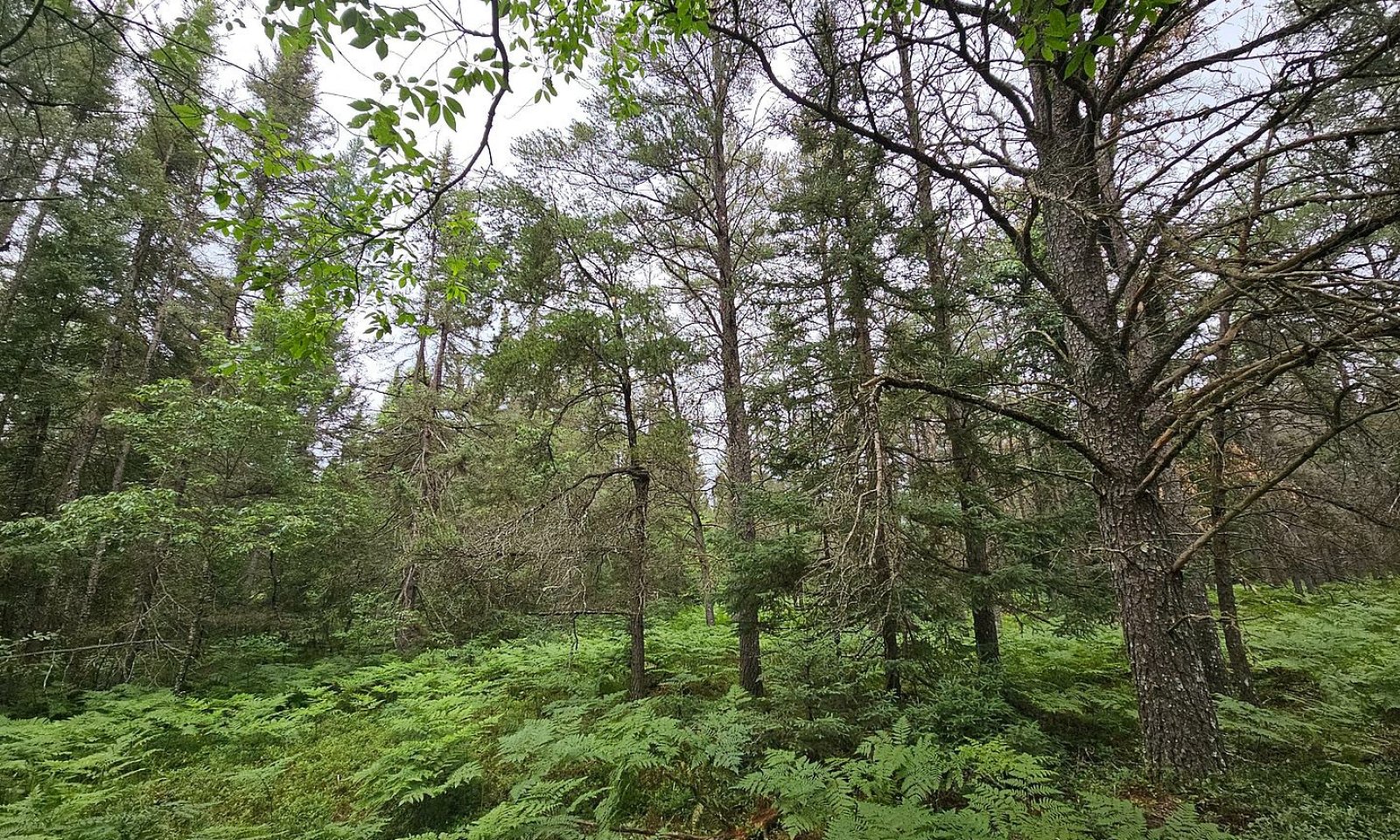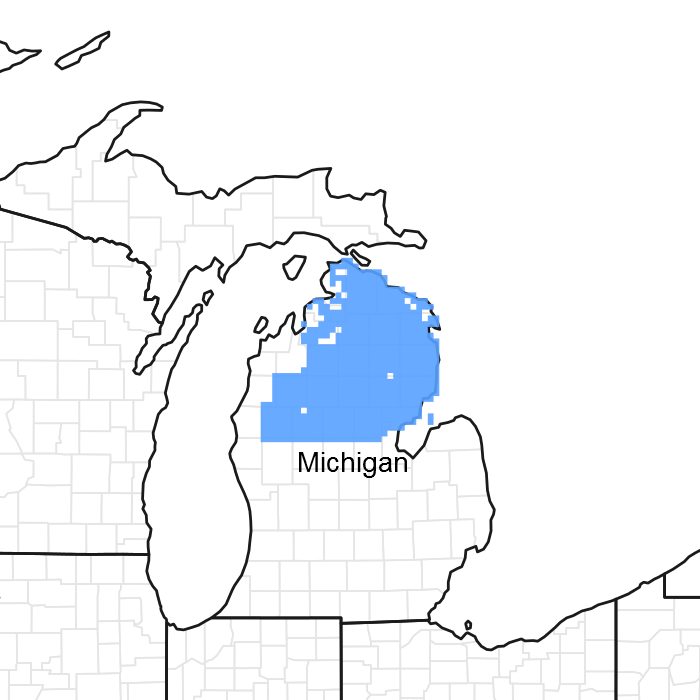

Natural Resources
Conservation Service
Ecological site F094AB020MI
Acidic Sandy Depression
Last updated: 2/25/2025
Accessed: 04/23/2025
General information
Provisional. A provisional ecological site description has undergone quality control and quality assurance review. It contains a working state and transition model and enough information to identify the ecological site.

Figure 1. Mapped extent
Areas shown in blue indicate the maximum mapped extent of this ecological site. Other ecological sites likely occur within the highlighted areas. It is also possible for this ecological site to occur outside of highlighted areas if detailed soil survey has not been completed or recently updated.
MLRA notes
Major Land Resource Area (MLRA): 094A–Northern Michigan Sandy Highlands
This area is dominated by outwash plains and moraines. The terrain can be steep on the moraines and flat in the areas of outwash. Elevation ranges from 177 to 520 m (580 to 1705 ft). Local topographic relief averages 14 m and ranges up to 188 m (45 to 615 ft). This area is covered entirely by drift. Bedrock consisting of Devonian limestone and dolomite with interbedded shale, chert, and anhydrite stringers is at various depths below the surface because of the curvature of the Michigan basin. However, bedrock exposures completely absent, as the depth of glacial drift ranges from 60 to 300 m (200-1000 ft). The Au Sable, Manistee, Au Gres, and Pine Rivers are the major streams draining this MLRA, in both the Lake Michigan and Lake Huron watersheds. The Muskegon River has its headwaters in this area.
About 70 percent of this area is forested, and about 15 percent is cropland or hayland. About one-third of the area is in small, privately owned holdings, and another one-third consists of national and State forests. The forests are used mainly for timber production and recreation. Dairy and beef operations are very important enterprises in the area. Forage and feed grains for dairy cattle and other livestock are the principal crops. Wheat, oats, corn, potatoes, and hay also are grown in the area. The Huron and Manistee National Forests, Hartwick Pines State Park, Camp Grayling (Department of Defense), Pigeon River Country State Forest are among the most notable conservation lands in the area. Reaches of the Au Sable and Pine Rivers are National Wild and Scenic Rivers.
Summary of existing land use:
Upland Forest (58%)
Hardwood (41%)
Conifer (15%)
Swamps and Marshes (14%)
Developed (11%)
Agricultural (10%)
Grassland (5%)
Classification relationships
According to the USFS (Bailey) system of ecoregions, the site is located mostly within 212Hg (Kirtland's Warbler High Sand Plains) and 212Hh (Gladwin Silty Lake Plain) subsections. According to the EPA (Omernik) system of ecoregions, the site is located in 50ae (Mio Plateau), 50ah (Tawas Lake Plain) and eastern 50ad (Vanderbilt Moraines) level IV ecoregions. This site roughly corresponds to PArVCo, in the Kotar system. This site corresponds to the Lowland, ecological land type phase, 62, in the USFS Ecological Land Type system.
Ecological site concept
The central concept of Acidic Sandy Depression is lowlands with a seasonal high watertable 25 to 100 cm deep (moderately well drained or somewhat poorly drained) and a soil pH of the upper 50 cm less than 5.5, and a low base saturation, including Spodosols, Ultic subgroups, and dysic great groups and families. Site occurs on sandy drift (outwash, ice contact, or lake plains) where soil textures are sand or loamy sand (upper 50 cm >70% sand). Site is outside the heavy snowfall belt, mostly east of Houghton Lake where fire was frequent. Vegetation trending towards mesophytic forest with an acidophilic species composition.
Associated sites
| F094AB021MI |
Wet Acidic Sandy Depression Wet Acidic Sandy Depression has a higher water table, and is hydric. Consequently, the vegetation is wetland, such as hardwood-conifer swamp. |
|---|---|
| F094AB019MI |
Dry Sandy Plains Dry Sandy Plains has a lower amount of spodic development reflecting higher productivity or has lower pH, which drives lower productivity. Vegetation tends to be more open with more jack pine and higher fire frequencies. |
Similar sites
| F094AA007MI |
Snowy Acidic Sandy Depression Snowy Acidic Sandy Depression has a greater amount of annual snowfall, and a lower fire frequency. Consequently, the species composition is less pine and more hemlock. |
|---|
Table 1. Dominant plant species
| Tree |
(1) Pinus strobus |
|---|---|
| Shrub |
Not specified |
| Herbaceous |
(1) Cornus canadensis |
Click on box and path labels to scroll to the respective text.
Ecosystem states
| T1A | - | Clear vegetation; cultivate crop species. |
|---|---|---|
| T1B | - | Clear vegetation, invasive species introduced. |
| R2 | - | Remove crop species; restore native species. |
| T2A | - | Abandoned, succession. |
| R3 | - | Control invasive species; restore native species. |
| T3A | - | Clear vegetation; cultivate crop species. |
State 1 submodel, plant communities
| 1.1A | - | Blowdown/clearcut/fire. |
|---|---|---|
| 1.2A | - | Succession |
